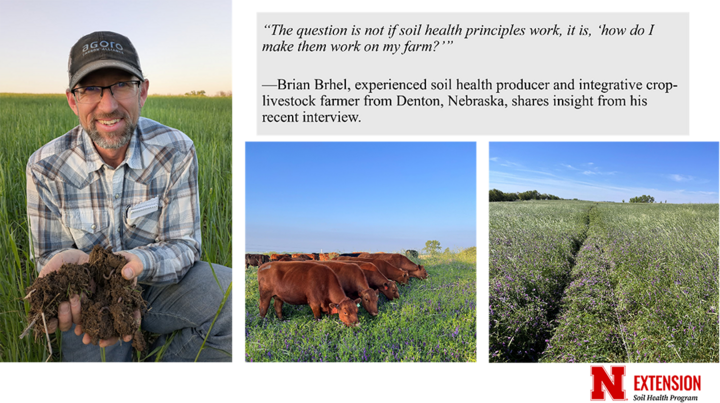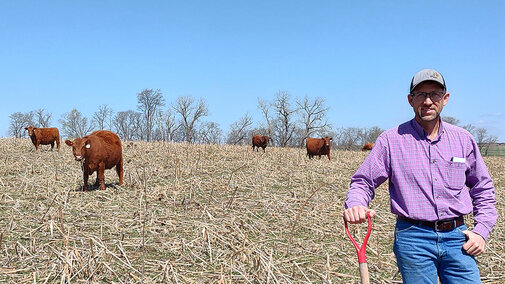This is the first in a new monthly series entitled "Soil Health Stories," featuring Nebraska farmers and ranchers. Each month, we will highlight producers who are demonstrating innovative practices and practical lessons that can inspire others across the state.
Nebraska farmer Brian Brhel has become known for his adaptive and thoughtful approach to soil stewardship. Farming near Denton, Nebraska, Brhel integrates diverse cover crops, grazing and rotations into his system to improve soil health, build resilience, and support his community.
Building Soil Health Through Diversity
For Brhel, diversity is at the heart of soil health. He experiments with different combinations of crops that bring multiple benefits to his farm.
"I like to be able to do one thing and get multiple benefits," Brhel said. "I like to plant multiple seeds together. One of those is oats and peas, and I’d like to include other seeds in those mixes as well — like flax, or even mustards."
By planting mixtures that include buckwheat, hairy vetch, oats, peas and flax, Brhel creates rotations that improve soil structure, provide forage or grazing options, and open potential for niche marketing.

The Challenge of Markets and Cash Flow
While the benefits to soil are clear, Brhel was candid about the realities of making regenerative systems financially sustainable.
"We can talk about all the fun, diverse rotations, but it really comes down to cash flow," he said. "If you don’t have cash flow, all these fun things don’t seem so fun anymore."
Brhel has developed a market for his oat and pea seed, making it a consistent part of his crop rotation. Still, finding steady buyers for less common crops remains challenging.
"It’s been difficult to find a steady market for some of the diverse crops I’m growing, even though they might be very valuable," he said. "Some of it is just patience — eventually I have been able to sell most of it."
Growing a cover crop for grazing has been a dependable source of income and supports our goals of soil improvement as well.
Soil Health and the Business of Farming
Brhel’s approach balances agronomic goals with economic realities — a lesson many producers can relate to.
"I can create all the soil health I want, but at the end of the day, I need the business to be sustainable," he said.
Key Takeaways for Producers
From Brhel’s experience, several insights stand out for other Nebraska farmers who are curious about regenerative practices:
- Start with diversity that connects to your market. Mixes like oats and peas can improve soil while meeting demand for feed and may also complement the seed market of small grains.
- Design for multiple benefits. Systems that allow both soil health gains and opportunities for grazing or marketing are more resilient.
- Balance agronomy and economics. Regenerative agriculture is only sustainable if it works for both the soil and the farmer’s bottom-line.
- Be patient with markets. Growth in niche crops and cover crop seed markets takes time to develop.
- Connect with extension and peers. Working in silos is no longer the norm and is not advisable; seek out support and stay up to date on research and information relevant to your crops and systems of interest.
Looking Ahead
Brhel continues to try new cover crop mixes and explore ways to connect them with market opportunities. His story reflects a broader shift among Nebraska producers who are working to weave together conservation, profitability and community health.
More Information
Want to hear Brian Brhel’s full story in his own words? Listen to the complete interview recording:
Brhel also welcomes growers to reach out via email or by calling 402-641-8915 for more information (please refer to this article for more context when calling).
Interested in Sharing Your Soil Health Story?
If you are also an advanced soil health producer in Nebraska or the surrounding region and would like us to share your story, please contact the UNL Soil Health team:

